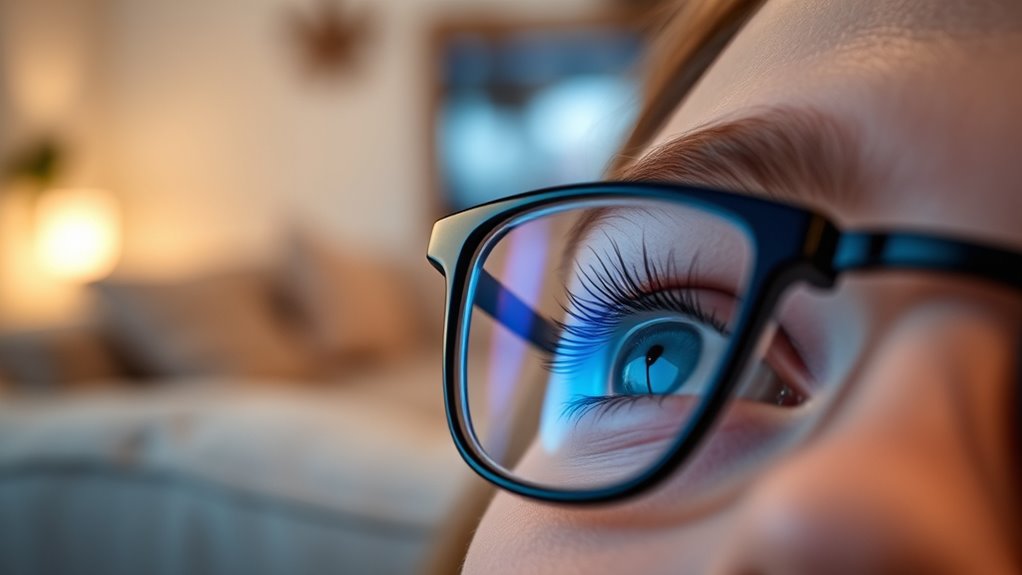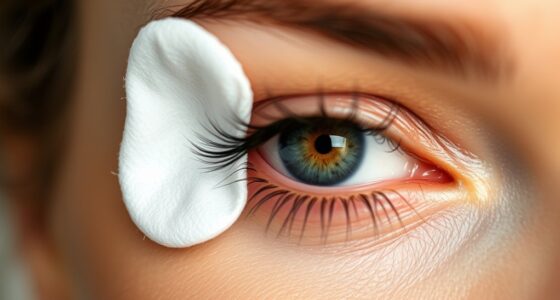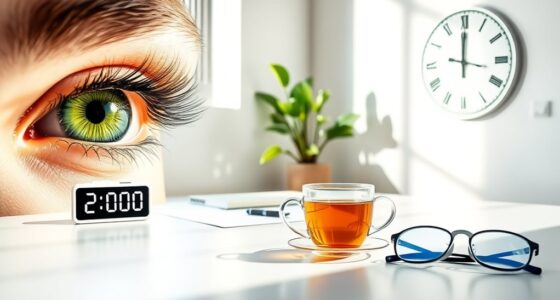Blue light blockers aren’t as effective as you might think for protecting your eyes from digital strain or sleep disruption. While blue light exposure can contribute to discomfort, it’s not the primary cause of eye strain. The American Academy of Ophthalmology states blue light is safe and doesn’t cause irreversible damage. Instead, taking regular breaks and practicing good eye habits are more essential. Keep exploring to discover more strategies for maintaining ideal eye health.
Key Takeaways
- Blue light does not cause irreversible eye damage, according to the American Academy of Ophthalmology.
- Limited evidence suggests blue light-blocking glasses significantly reduce digital eye strain.
- Symptoms attributed to blue light exposure often stem from reduced blinking and prolonged screen focus.
- Following the 20-20-20 rule can effectively relieve digital eye strain more than blue light blockers.
- Regular eye breaks and proper screen adjustments are more beneficial for eye comfort than relying on blue light filters.
Understanding Blue Light and Its Sources

Blue light, which ranges from 400 to 500 nanometers in wavelength, is all around you, coming from both natural and artificial sources.
Sunlight is the largest natural source, while digital devices like smartphones and computers emit significant amounts of blue light.
With Americans averaging over 7 hours of screen time daily, you might experience symptoms of digital eye strain, such as discomfort and fatigue.
The American Academy of Ophthalmology confirms that while blue light exposure from screens doesn’t cause eye damage, it can disrupt your circadian rhythm, affecting sleep quality, especially in the evening.
Understanding these sources can help you manage your eye health effectively while using digital devices.
Are Blue Light Blockers Effective?

Are blue light blockers really worth the hype?
Research suggests that blue light-blocking glasses may not be as effective as you think. A review of 17 studies found limited scientific evidence supporting their ability to reduce eye strain compared to standard lenses.
In fact, a 2021 study revealed no substantial difference in relief from digital eye strain between users of blue light glasses and those wearing placebo lenses.
The American Academy of Ophthalmology states there’s no proof that blue light causes irreversible eye damage. Symptoms like eye strain are more likely linked to reduced blinking and prolonged focus rather than blue light exposure.
While some users report improved sleep, the evidence remains inconclusive, indicating more research is needed.
The Science Behind Digital Eye Strain

As you spend more time in front of screens, the discomfort known as digital eye strain can become increasingly apparent. This condition, often referred to as computer vision syndrome, encompasses various eye strain symptoms like blurred vision, headaches, and dry eyes.
With the average American spending over 7 hours daily on digital devices, the prevalence of these symptoms is staggering. Factors contributing to digital eye strain include glare from screens, infrequent blinking, and constant focus shifts rather than blue light exposure itself.
In fact, research shows that up to 69% of computer users report experiencing discomfort due to prolonged exposure. The American Academy of Ophthalmology emphasizes that blue light doesn’t cause eye damage, pointing to other factors as the real culprits behind your discomfort.
What Research Says About Blue Light Glasses

When it comes to blue light glasses, research shows mixed results regarding their effectiveness in reducing eye strain.
Studies indicate that the symptoms often associated with screen use are more linked to how long you focus and how often you blink, rather than the blue light itself.
Effectiveness of Blue Light Glasses
Although many people turn to blue light glasses hoping to reduce eye strain and improve sleep, research suggests these eyewear options may not be as effective as expected. A review of 17 studies reveals limited evidence supporting their effectiveness. The American Academy of Ophthalmology states that blue light isn’t harmful and doesn’t cause irreversible eye damage. Symptoms often linked to blue light exposure, like eye strain, are more likely due to reduced blinking and prolonged focus. Experts recommend focusing on good habits instead of relying solely on blue light glasses.
| Study Findings | Effectiveness of Blue Light Glasses | Experts’ Opinions |
|---|---|---|
| Limited evidence | Not markedly effective | No endorsement for special eyewear |
| No improvement in sleep quality | No vision performance boost | Focus on habits instead |
| Eye symptoms linked to habits | Similar to placebo | Reduce screen time |
| Prolonged focus issues | Do not alleviate discomfort | Maintain good posture |
| Lack of notable relief | Not a solution for eye strain | Prioritize regular breaks |
Eye Strain and Relief
Many people believe that blue light glasses can alleviate eye strain, but research indicates otherwise.
Studies show that these glasses don’t markedly reduce symptoms of digital eye strain or computer vision syndrome. In fact, eye strain often stems from factors like reduced blinking and prolonged focus rather than blue light exposure.
Here are some effective strategies to manage eye strain:
- Follow the 20-20-20 rule: every 20 minutes, look at something 20 feet away for 20 seconds.
- Take regular eye breaks to relax your eyes.
- Adjust your screen brightness and contrast.
- Maintain proper distance from your screen.
- Confirm good lighting to reduce glare.
The American Academy of Ophthalmology emphasizes that blue light is safe and not a major cause of eye irritation.
Alternatives to Blue Light Blockers for Eye Health

If you’re looking for ways to protect your eyes without blue light blockers, consider adjusting your screen time habits.
Implementing the 20-20-20 rule and ensuring proper lighting can make a significant difference in reducing eye strain.
Regular breaks and eye exercises can also keep your vision sharp and comfortable during long hours in front of screens.
Screen Time Management
As screen time continues to dominate our daily routines, finding effective alternatives to blue light blockers for maintaining eye health is essential.
Here are some practical strategies for screen time management:
- Limit screen time to 2-3 hours before bedtime to improve sleep quality.
- Follow the 20-20-20 rule: every 20 minutes, look at something 20 feet away for 20 seconds to reduce eye strain.
- Schedule regular eye exams every 2-3 years to catch vision problems early.
- Use matte screen filters or adjust brightness on computer screens to minimize glare.
- Incorporate artificial tears or lubricating drops to alleviate dryness and discomfort.
Eye Exercises and Breaks
Maintaining eye health goes beyond managing screen time; incorporating eye exercises and regular breaks can greatly enhance your comfort and reduce strain. Try the 20-20-20 rule: every 20 minutes, look at something 20 feet away for 20 seconds. This practice increases your blink rate and relaxes your eyes, combating digital eye strain. Additionally, take breaks to stand up and move around, which helps alleviate discomfort. It’s also important to stay hydrated, as hydration is crucial for overall eye health.
| Activity | Benefits | Frequency |
|---|---|---|
| Eye Rolling | Improves coordination | Every hour |
| Focus Shifting | Reduces fatigue | Every 20 minutes |
| Blink Exercises | Increases moisture | As needed |
| Hydration | Combats dryness | Throughout day |
| Artificial Tears | Provides relief | As needed |
Incorporate these practices for better eye health!
Proper Lighting Techniques
Proper lighting techniques play an essential role in protecting your eyes from strain, especially when you spend long hours in front of screens.
Here are some effective methods to enhance your visual comfort:
- Use ambient and task lighting to reduce glare on your screen.
- Adjust your screen brightness to match the surrounding light for ideal viewing.
- Position screens away from direct overhead lighting to minimize glare.
- Consider using matte screen filters to diffuse harsh light and reflections.
- Implement the 20-20-20 rule: every 20 minutes, look at something 20 feet away for 20 seconds. Additionally, improving your overall environment with air purifiers can lead to better indoor air quality, which contributes to overall well-being and comfort while working. Regular use of air purifiers can help reduce allergens in the environment, enhancing performance and reducing eye strain from inadequate lighting. Proper airflow around your workspace can enhance performance and reduce eye strain from inadequate lighting.
The Role of Blinking in Eye Comfort

While many people focus on the blue light emitted by screens, they often overlook the importance of blinking in maintaining eye comfort.
With prolonged screen time, your blinking rate drops considerably, leading to increased tear evaporation and dry eyes. Blinking is essential for keeping your eyes moist and comfortable, as it helps distribute tears evenly across the surface.
To combat digital eye strain, try the 20-20-20 rule: every 20 minutes, look at something 20 feet away for 20 seconds. This simple practice encourages blinking and refreshes your tear film, promoting better eye health.
Recommendations for Reducing Eye Strain

Extended screen time can really take a toll on your eyes, making it important to adopt strategies for reducing eye strain. Here are some recommendations to help you maintain eye comfort:
- Follow the 20-20-20 rule: every 20 minutes, look at something 20 feet away for 20 seconds.
- Limit screen time to 2-3 hours before bedtime to minimize blue light exposure.
- Use artificial tears or lubricating eye drops to combat dryness.
- Adjust your screen’s brightness and position to reduce glare.
- Schedule regular eye exams every 2-3 years to catch potential issues early.
Incorporating these tips can help you manage eye strain and guarantee your vision remains clear, whether you’re wearing glasses or using blue blockers.
Frequently Asked Questions
Do Blue Light Glasses Actually Protect Your Eyes?
You might wonder if blue light glasses actually protect your eyes.
While they filter some blue light, studies show they don’t greatly reduce eye strain or improve comfort.
The American Academy of Ophthalmology states blue light isn’t harmful and doesn’t recommend special eyewear.
Instead, try taking regular breaks and practicing the 20-20-20 rule to alleviate symptoms.
If you want to wear them, they’re harmless, but they may not be necessary for eye health.
Can You Reverse Blue Light Eye Damage?
You can’t reverse blue light eye damage because there’s no evidence it causes long-term harm.
While you’re right to be cautious about screen time, the discomfort you might feel is typically temporary and manageable through good eye care practices.
Proper habits like taking regular breaks and ensuring proper lighting can help.
Do Doctors Ever Recommend Blue Light Glasses?
Did you know that about 60% of adults report experiencing digital eye strain?
When it comes to blue light glasses, most doctors don’t recommend them for everyday use. They often argue that there’s no solid evidence that blue light causes permanent damage or alleviates symptoms you might feel from screen time.
Instead, focusing on proper eye care practices, like taking breaks and reducing glare, is what’ll truly help you maintain eye health.
What Is the Disadvantage of Blue Light Blocking Glasses?
The main disadvantage of blue light blocking glasses is that they often don’t deliver the promised relief from eye strain.
Studies show they don’t greatly improve symptoms compared to regular lenses. You might find that they filter some blue light, but not enough to make a real difference.
Plus, they can be pricey, and many eye care experts suggest that other factors, like reduced blinking, are the root causes of digital eye strain.
Conclusion
In a world where screens dominate our lives, taking care of your eyes has never been more essential. While blue light blockers may offer some benefits, remember that simple habits like regular breaks and proper blinking can be just as effective. Isn’t it worth investing a little time in your eye health? After all, your vision is a precious gift—cherish it, and you’ll see the world in all its vibrant glory for years to come.










